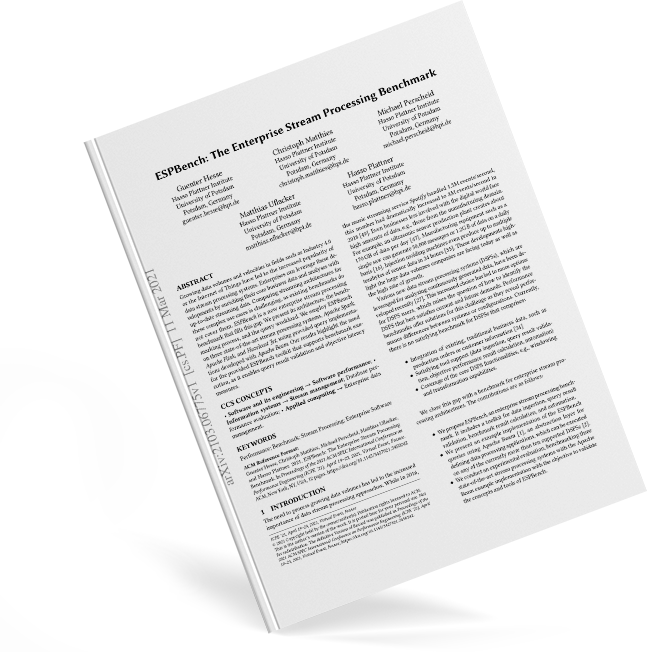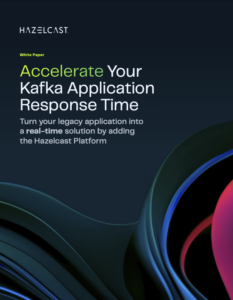Apache Kafka + Hazelcast for Developers
You can be doing more with your Apache Kafka applications. They can be faster and more connected than ever before with Hazelcast.
Kafka Unleashed
As countless people have asserted over the years - data is the new oil. Just like oil that sits underground, undiscovered, untapped, its full potential goes unfulfilled. The power that is unleashed from oil that is pumped to the surface is the same as data that is transformed from data-at-rest to data-in-motion.
Developers who can see this potential from their current Apache Kafka solutions that implement the typical producer/consumer paradigm. These Apache Kafka solutions have data pipelines that are left untapped. Apache Kafka with the Hazelcast Platform can unleash the untapped value of these data reserves.
Learn how Hazelcast out-performed Apache Flink and Spark
 The ESPBench paper from the Hasso Plattner Institute compares the performance of popular stream processors. This independent report benchmarked Hazelcast against Apache Flink and Apache Spark. It states, "Overall, the latency results are diverse with Hazelcast [Jet] often performing best with respect to the 90%tile and mean values."
The ESPBench paper from the Hasso Plattner Institute compares the performance of popular stream processors. This independent report benchmarked Hazelcast against Apache Flink and Apache Spark. It states, "Overall, the latency results are diverse with Hazelcast [Jet] often performing best with respect to the 90%tile and mean values."
Discover the potential that real-time economy can unlock for your business through our webinar.
Why choose Hazelcast to get your Kafka investment to the next level? There are three strong technology advantages that make Hazelcast the ideal choice to boost Kafka.
Champion Innovation
01
Streamline
02
Automate
03
Enhance

Learn how to get more value from Kafka
Kafka + Hazelcast in Action
Here’s a quick example that shows Kafka + Hazelcast in Action. This is a code snippet from the Patient Monitoring Solution which demonstrates how easy it is to turn data-at-rest into data-in-motion.
In the Patient Monitoring Solution, the Pipeline Implementation class creates Hazelcast streaming pipelines and jobs for each of the devices monitoring the patient. A Pipeline Factory class creates each Pipeline object. In the createPipeline() function below, the topicMapNameIn parameter is associated with the device name. For example, the “heart” device would have a “heart” topicMapNameIn value. The topicMapNameIn also corresponds to the ebTopicName from the produceRecords() function above. (13) Each pipeline object is tied to a device (ebTopicName/TopicMapNameIn). (16) After the pipeline is read in the record from Kafka it will create a map entry in the (18) Patient map. (18) The EntryProcessorImpl class matches subsequent device records with the Patient to create a complete Patient record for this instance. (20) The device record is written to the corresponding device map. (22) The Patient record is sent to the Results map for scoring. (23) All output is written to the console.
public static Pipeline createPipeline(
String hazelcastIpAddressIn,
String patientMapIn,
String topicMapNameIn,
String processorNameIn,
String processorPortIn
) {
// Initialize an empty pipeline
Pipeline pipeline = Pipeline.create();
try {
// Read from the Message Bus (Apache Kafka)
StreamStage<Entry<String, String>> streamStage = pipeline.readFrom(KafkaSources.<String, String>kafka(kafkaProps(), topicMapNameIn))
.withoutTimestamps()
.map(r -> entry(r.getKey(), r.getValue()));
// Write to Patient Map
streamStage.writeTo(Sinks.mapWithEntryProcessor(patientMapIn, entryKey(), e -> new EntryProcessorImpl(topicMapNameIn, e.getValue(), new Patient(e.getKey()))));
// Write to Device Map
streamStage.writeTo(Sinks.map(topicMapNameIn));
// Sink is designated to send results
streamStage.writeTo(Result.buildGraphiteSink(hazelcastIpAddressIn, topicMapNameIn, processorNameIn, processorPortIn));
// Write to log
streamStage.writeTo(Sinks.logger());
} catch (Exception e) {
e.printStackTrace();
}
return pipeline;
}
Accelerate Your Learning
Get started with Hazelcast today. We have resources to help you learn. Check these out!
Webinar
Streaming SQL on Apache Kafka for Real-Time Processing
White Paper
The Hazelcast and Apache Kafka Transaction Processing Reference Architecture
Blog
Enriching Kafka Applications with Contextual Data
Use Case
Why Apache Kafka and Hazelcast
Course
Stream Processing Essentials
Ready for more? Visit our Resource Center.